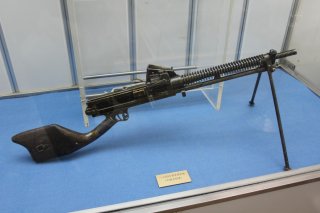Imperial Japan’s Type 11 Was World War II’s Worst Machine Gun
The Type 11, named after the eleventh year of the reign of Emperor Taishō, or 1922, was modeled after the French Hotchkiss air-cooled, gas-operated heavy machine gun.
Here's What You Need to Remember: Despite the introduction of those superior weapons the Japanese Imperial Army and Special Naval Landing Forces continued to rely on the Type 11 until the end of war. Captured Type 11 machine guns were also used by both sides in the Chinese Civil War, while North Korea, the Viet Minh, and the Viet Cong all used the weapon in limited capacity.
When it comes to military small arms there is always a debate over "The Best"—but equally debatable is what were some of the worst. The years leading up to and during the Second World War saw some truly excellent firearms developed, including the U.S. M2 .50 caliber heavy machine gun, and notably the German MG-34 and MG-42 general purpose machine guns.
However, the Japanese military earns the prize for developing what was perhaps the worst machine gun of World War II and possibly of all time. Meet the Type 11.
Since opening to the west the Japanese Army followed a French influence and this was noted not just in its early uniforms but also equipment and small arms. The Type 11, named after the eleventh year of the reign of Emperor Taishō, or 1922, was modeled after the French Hotchkiss air-cooled, gas-operated heavy machine gun. However, the Japanese wanted something more mobile—a weapon that could be used in an offensive as well as defensive role.
Japanese small arms designer Kijiro Nambu was tasked with developing such a weapon—one that would also be chambered for the same cartridges as the main battle rifle. Instead of being fed by 24-round or 30-round brass ammunition strips like the French Mle 1914 Hotchkiss,which worked well with a three man crew, the weapon was loaded via a hopper, which could hold up to six 5-round stripper clips of 6.5x50mm ammunition.
In theory this offered the benefit of being able to be continuously reloaded, while the stripper clips were the same ones used to load the Type 38 Ariska rifle. The stripper clips went into the hopper on their side, while a ratcheting feed mechanism chambered each round, fired it and after all five bullets were fired the strip was ejected with the empty cartridge.
It surely must have seemed like an elegant solution to the Nambu and his design team.
In reality, the gas-operated weapon wasn't strong enough to extract each cartridge, so to solve the problem an integral pump oiled each of the rounds. In an ideal environment that would have done the trick, but a battlefield is far from an ideal environment in the best case scenario. The oil mixed with dirt, mud, grass, and other debris and that caused jams.
A bigger problem was that the rate of fire had to be kept reasonably low or else the complicated feed system would further jam and exacerbate the aforementioned problems. To resolve the rate of the fire, a special lower-powered 6.5mm round had to be produced. That in turn defeated the whole purpose of using a hopper that could be fed with the standard rifle ammunition.
While reloading from a fixed position was actually easy, it was nearly impossible to reload quickly while on the move, and as the rounds weren't on a belt or in a magazine, stacked stripper clips could spill out whenever a soldier tried to advance if the gun was jarred or even tilted slightly. This meant that the gun had to be kept only partially loaded until it was in a stable position, which also defeated its intended purpose.
The hopper feed system also made the gun imbalanced when firing due to the weight of the rifle-caliber cartridges stacked together on one side. It was ungainly in other ways, including the pistol grip that was incorporated into an overlarge butt stock, which was offset to the right of the weapon's centerline while the finned barrel rested on a long-legged bipod that made stability on anything but perfectly level ground another issue.
During the Manchurian Incident in 1931, the Japanese military noted the problems of the Type 11, and Nambu developed a replacement. The Type 96, which resembled the Czech-made ZB vz. 26 or British Gun, utilized a conventional 30-round box magazine. The Type 96 and the later Type 99 proved more reliable and offered the ability to provide mobile fire.
Despite the introduction of those superior weapons the Japanese Imperial Army and Special Naval Landing Forces continued to rely on the Type 11 until the end of war. Captured Type 11 machine guns were also used by both sides in the Chinese Civil War, while North Korea, the Viet Minh, and the Viet Cong all used the weapon in limited capacity.
Peter Suciu is a Michigan-based writer who has contributed to more than four dozen magazines, newspapers and websites. He is the author of several books on military headgear including A Gallery of Military Headdress, which is available on Amazon.com. This first appeared earlier and is being reposted due to reader interest.
Image: Wikipedia.

